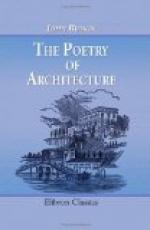134. The mere preparation of convenience, therefore, is not architecture in which man can take pride, or ought to take delight;[21] but the high and ennobling art of architecture is that of giving to buildings, whose parts are determined by necessity, such forms and colors as shall delight the mind, by preparing it for the operations to which it is to be subjected in the building: and thus, as it is altogether to the mind that the work of the architect is addressed, it is not as a part of his art, but as a limitation of its extent, that he must be acquainted with the minor principles of the economy of domestic erections. For this reason, though we shall notice every class of edifice, it does not come within our proposed plan, to enter into any detailed consideration of the inferior buildings of each class, which afford no scope for the play of the imagination by their nature or size; but we shall generally select the most perfect and beautiful examples, as those in which alone the architect has the power of fulfilling the high purposes of his art. In the villa, however, some exception must be made, inasmuch as it will be useful, and perhaps interesting, to arrive at some fixed conclusions respecting the modern buildings, improperly called villas, raised by moderate wealth, and of limited size, in which the architect is compelled to produce his effect without extent or decoration. The principles which we have hitherto arrived at, deduced as they are from edifices of the noblest character, will be but of little use to a country gentleman, about to insinuate himself and his habitation into a quiet corner of our lovely country; and, therefore, we must glance at the more humble homes of the Italian, preparatory to the consideration of what will best suit our own less elevated scenery.
[Footnote 21: [Compare “The Seven Lamps of Architecture,” chap. i. Sec. 1.]]
135. First, then, we lose the terraced approach, or, at least, its size and splendor, as these require great wealth to erect them, and perpetual expense to preserve them. For the chain of terraces we find substituted a simple garden, somewhat formally laid out; but redeemed from the charge of meanness by the nobility and size attained by most of its trees; the line of immense cypresses which generally surrounds it in part, and the luxuriance of the vegetation of its flowering shrubs. It has frequently a large entrance gate, well designed, but carelessly executed; sometimes singularly adorned with fragments of ancient sculpture, regularly introduced, which the spectator partly laments, as preserved in a mode so incongruous with their ancient meaning, and partly rejoices over, as preserved at all. The grottoes of the superior garden are here replaced by light ranges of arched summerhouses, designed in stucco, and occasionally adorned in their interior with fresco paintings of considerable brightness and beauty.




